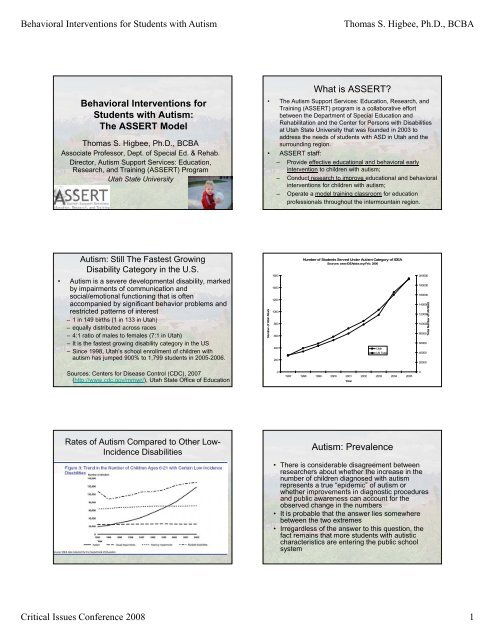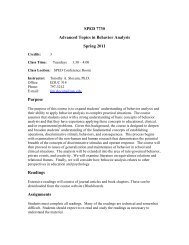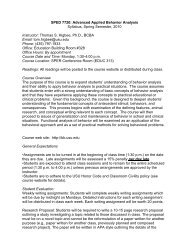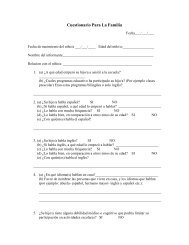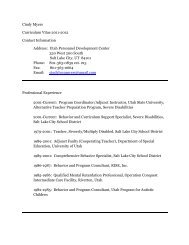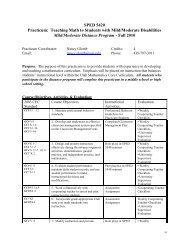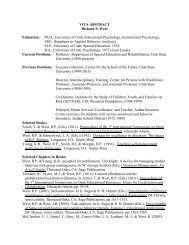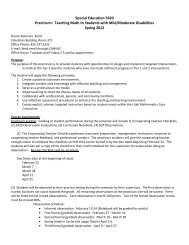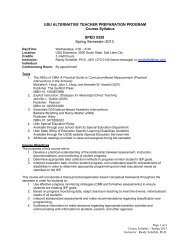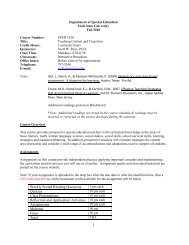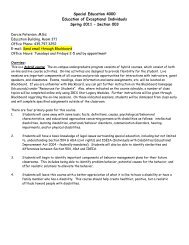Behavioral Interventions for Students with Autism Thomas S. Higbee ...
Behavioral Interventions for Students with Autism Thomas S. Higbee ...
Behavioral Interventions for Students with Autism Thomas S. Higbee ...
You also want an ePaper? Increase the reach of your titles
YUMPU automatically turns print PDFs into web optimized ePapers that Google loves.
<strong>Behavioral</strong> <strong>Interventions</strong> <strong>for</strong> <strong>Students</strong> <strong>with</strong> <strong>Autism</strong><strong>Thomas</strong> S. <strong>Higbee</strong>, Ph.D., BCBA<strong>Behavioral</strong> <strong>Interventions</strong> <strong>for</strong><strong>Students</strong> <strong>with</strong> <strong>Autism</strong>:The ASSERT Model<strong>Thomas</strong> S. <strong>Higbee</strong>, Ph.D., BCBAAssociate Professor, Dept. of Special Ed. & Rehab.Director, <strong>Autism</strong> Support Services: Education,Research, and Training (ASSERT) ProgramUtah State UniversityWhat is ASSERT?• The <strong>Autism</strong> Support Services: Education, Research, andTraining (ASSERT) program is a collaborative ef<strong>for</strong>tbetween the Department of Special Education andRehabilitation and the Center <strong>for</strong> Persons <strong>with</strong> Disabilitiesat Utah State University that was founded in 2003 toaddress the needs of students <strong>with</strong> ASD in Utah and thesurrounding region.• ASSERT staff:– Provide effective educational and behavioral earlyintervention to children <strong>with</strong> autism;– Conduct research to improve educational and behavioralinterventions <strong>for</strong> children <strong>with</strong> autism;– Operate a model training classroom <strong>for</strong> educationprofessionals throughout the intermountain region.<strong>Autism</strong>: Still The Fastest GrowingDisability Category in the U.S.• <strong>Autism</strong> is a severe developmental disability, markedby impairments of communication andsocial/emotional functioning that is oftenaccompanied by significant behavior problems andrestricted patterns of interest– 1 in 149 births (1 in 133 in Utah)– equally distributed across races– 4:1 ratio of males to females (7:1 in Utah)– It is the fastest growing disability category in the US– Since 1998, Utah’s school enrollment of children <strong>with</strong>autism has jumped 900% to 1,799 students in 2005-2006.Number of Uta ah Stude1600140012001000800600400200Number of <strong>Students</strong> Served Under <strong>Autism</strong> Category of IDEASources: www.IDEAdata.org-Feb. 2006UtahUS Total200000180000160000Total Numbe er of US Stud14000012000010000080000600004000020000Sources: Centers <strong>for</strong> Disease Control (CDC), 2007(http://www.cdc.gov/mmwr/), Utah State Office of Education01997 1998 1999 2000 2001 2002 2003 2004 2005Year0Rates of <strong>Autism</strong> Compared to Other Low-Incidence Disabilities<strong>Autism</strong>: Prevalence• There is considerable disagreement betweenresearchers about whether the increase in thenumber of children diagnosed <strong>with</strong> autismrepresents a true “epidemic” of autism orwhether improvements in diagnostic proceduresand public awareness areness can account <strong>for</strong> theobserved change in the numbers• It is probable that the answer lies somewherebetween the two extremes• Irregardless of the answer to this question, thefact remains that more students <strong>with</strong> autisticcharacteristics are entering the public schoolsystemCritical Issues Conference 2008 1
<strong>Behavioral</strong> <strong>Interventions</strong> <strong>for</strong> <strong>Students</strong> <strong>with</strong> <strong>Autism</strong><strong>Thomas</strong> S. <strong>Higbee</strong>, Ph.D., BCBALevels of Scientific Evidence• What constitutes “research”? What kinds of researchmust be done on a particular technique be<strong>for</strong>e it isconsidered “research-based”?• Generally speaking, controlled, experimentalresearch needs to be conducted multiple times inorder <strong>for</strong> a technique to be considered d “researchbased”• Case studies and anecdotal reports are not sufficient<strong>for</strong> establishing an approach as research-based• Group design studies using control groups or multiplesingle-case experimental design studies arenecessaryResearch on Early Intensive ABA• While researchers have thus far been unsuccessful inidentifying the cause of autism, they have developedeffective methods <strong>for</strong> treating the disorder• Research has shown that while children <strong>with</strong> autism donot learn readily from typical educational environments,they can learn a great deal when the environment isappropriately constructed• Research has consistently demonstrated that successfultreatments <strong>for</strong> children <strong>with</strong> autism are those based onprinciples of Applied Behavior Analysis (ABA)• Research has also shown that behavioral interventionsare most effective when they are intense (30-40 hoursper week) and started at a young age (3-5 years of age)• These same strategies, however, have been usedsuccessfully <strong>with</strong> older students as wellWhat is “ABA”?• Over the past 50 years, scientists havedemonstrated through countless researchstudies that the environmental events thatsurround behavior directly impact on howlikely that behavior is to be repeated in thefuture• Behavior Analysis is the name of thescientific field that studies behavior and theenvironmental events that influence it• Applied Behavior Analysis (ABA) is thebranch of the field that takes basic behavioralprinciples learned in the research laboratoryand applies them to improve the humanconditionBasic ABA Principles• Research tells us that the consequences produced bybehavior have a dramatic impact on future rates of behavior• The behavioral process by which behavior is strengthened iscalled rein<strong>for</strong>cement• Positive Rein<strong>for</strong>cement is the behavioral operation ofproviding a consequence following a behavior that results inthat behavior being more likely to occur in the future• In discrete trial teaching, we provide the student <strong>with</strong>repeated opportunities to receive positive rein<strong>for</strong>cement <strong>for</strong>engaging in desired behaviors, thus making these behaviorsmore likely to occur in the future• Undesired behaviors are not followed by rein<strong>for</strong>cement,making these behaviors less likely to occur in the future.Research on Early Intensive ABA• Over 550 studies published from 1960-1995 (Matson etal., 1996) document the effectiveness of ABA techniques<strong>for</strong> building skills in individuals <strong>with</strong> autism• Documentation of the effectiveness of a comprehensiveearly intensive ABA program in a controlled study <strong>with</strong>long-term follow-up by Lovaas (1987) and McEachin,Smith, & Lovaas (1993)• Multiple partial and systematic replications of Lovaasmodel have taken place since 1993• Various state and federal agencies have acknowledgedthe proven effectiveness of EIBI (New York State Dept. ofHealth, Maine Administrators of Services <strong>for</strong> Children <strong>with</strong>Disabilities, U.S. Surgeon General Report on MentalHealth, 1999)• Additionally, review panels of professional associationssuch as the American Academy of Child and AdolescentPsychiatry, the American Academy of Neurology, and theAmerican Academy of Pediatrics report that EIBI is highlyeffective in meeting the needs of children <strong>with</strong> autismAre other treatments effective?• To date, no other treatment approaches havebeen demonstrated, through controlledresearch, to produce comparable student gainsto early intensive ABA approaches• This has not stopped the development of “fad”interventions (e.g., Secretin therapy, sensoryintegration therapy, megavitamin therapy,special diets, holding therapy, dolphin therapy,mercury detoxification, etc.) and,• other systematically designed interventions (e.g.,TEACCH, Floortime, etc.) that either have notbeen subjected to controlled research or havefailed to produce comparable effects to ABACritical Issues Conference 2008 2
<strong>Behavioral</strong> <strong>Interventions</strong> <strong>for</strong> <strong>Students</strong> <strong>with</strong> <strong>Autism</strong><strong>Thomas</strong> S. <strong>Higbee</strong>, Ph.D., BCBACharacteristics of a “State of the Art”ABA Program <strong>for</strong> Children <strong>with</strong> <strong>Autism</strong>• Curriculum-based assessments are used to create anindividualized instructional and behavioral program <strong>for</strong>each student that addresses all behavioral deficits andexcesses (e.g., social, communicative, academic,behavioral, etc.)• Complex skills are broken down into their componentparts and simple skills are built into more complex ones• <strong>Students</strong> are provided <strong>with</strong> many learning trials to practiceemerging skills and these skills are practiced in bothstructured and unstructured environments• Multiple research-based instructional techniques are usedto provide learning trials (e.g., discrete-trial teaching,incidental teaching, prompting and prompt fadingprocedures, social scripts and script fading procedures,naturalistic language techniques, etc.)Characteristics of a “State of the Art”ABA Program <strong>for</strong> Children <strong>with</strong> <strong>Autism</strong>• Correct responses are followed by rein<strong>for</strong>cersthat have been systematically identified and areappropriate <strong>for</strong> the individual at that time• Over time, primary rein<strong>for</strong>cers (e.g., edibles) arefaded and replaced <strong>with</strong> social rein<strong>for</strong>cers andaccess to age appropriate play materials• <strong>Students</strong> are taught over time to tolerate delaysbe<strong>for</strong>e receiving rein<strong>for</strong>cement (e.g., usingsimple token systems to gain access topreferred toys/games)• Emphasis is on making the learning processenjoyable <strong>for</strong> the child• Curriculum decisions are based on objectivelydefined and measured student dataCharacteristics of a “State of the Art”ABA Program <strong>for</strong> Children <strong>with</strong> <strong>Autism</strong>• Aberrant behavior is addressed through functionalassessment and intervention techniques (i.e., aberrantbehavior placed on extinction and replacement behaviortaught and rein<strong>for</strong>ced)• There is no “down time”. Instruction is embedded intoevery activity during the day• Steps are taken to promote generalization andmaintenance of student skills including having the studentregularly receive instruction from multiple instructors andin multiple environments• Parents are taught how to address aberrant behavior andsupport emerging appropriate behavior in the home• The program is directed by individuals <strong>with</strong> graduatetraining in behavior analysis and specific training andexperience in behavioral interventions <strong>for</strong> students <strong>with</strong>autism (we now have international certification <strong>for</strong>behavior analysts: www.bacb.com)Characteristics of a “State of the Art”ABA Program <strong>for</strong> Children <strong>with</strong> <strong>Autism</strong>• The overall emphasis is on teaching the child to learnfrom his/her natural environment (like typical kids do)• As the student develops the necessary skills, instructionis gradually changed from strict, intensive 1:1 instructionto settings and instructional styles that approximatetypical educational environments (e.g., small- and largegroupinstruction, social and delayed rein<strong>for</strong>cement,fewer specific instructions)• As the student develops the necessary skills, he/sheengages in structured social/play activities <strong>with</strong> typicallydeveloping peers• When students are transitioned out of intensive ABAprograms into traditional regular or special educationprograms, the transition is planned, systematic, andtakes place over time in response to the student’s needsABA-Based Teaching Techniques• Discrete Trial Teaching• Social Scripting/Script Fading• Activity Schedules• Mand Training• Video Modeling• Naturalistic Teaching TechniquesDiscrete Trial Teaching• Discrete Trial Teaching (DTT) is the most commonABA-based treatment approach <strong>for</strong> children <strong>with</strong> ASD• In the DTT approach, students are provided <strong>with</strong> manyrepeated opportunities (called learning “trials”) topractice specific skills and receive direct feedbackfrom an instructor• Instruction is rapidly paced and each student usuallyhas their own individual instructor• When students need extra help to per<strong>for</strong>m specificlearning tasks, the instructor prompts, or cues, them tomake the correct response and then provides apositive consequence• Theses prompts are then removed over time so thatthe student can per<strong>for</strong>m the skill independently• DTT has been repeatedly shown to be an effectiveteaching technique <strong>for</strong> students <strong>with</strong> ASD and can beused to teach many different kinds of skillsCritical Issues Conference 2008 3
<strong>Behavioral</strong> <strong>Interventions</strong> <strong>for</strong> <strong>Students</strong> <strong>with</strong> <strong>Autism</strong><strong>Thomas</strong> S. <strong>Higbee</strong>, Ph.D., BCBAGain theChild’sAttentionDiscrete Trial TeachingPresentInstructionDTTExample #1ProvidePrompt (ifNecessary)ChildRespondsProvideConsequenceRecordDataAppropriately Gaining the Child’sAttention• Be<strong>for</strong>e giving a child an instruction, it isimportant to gain the child’s attention.• The best indicator that a child is attending iswhen he/she is looking you in the eyes.• The child’s attention can be gained by doinga variety of things, including:– saying the child’s name (however, it is important not to saythe child’s name on every trial or the child may stop payingattention when his/her name is called)– making some other sound that attracts the child’s attention– by placing open hand at the side of their head to block visualstimuli– by gently touching the child– by waiting <strong>for</strong> the child to naturally make eye contact <strong>with</strong>you Video exampleProvide the Instruction (S D )• After you have gained the child’s attention(you have eye contact), the next step is toprovide the instruction (e.g., “Touch yourarm.”, “What is your name?”, “How do youspell ‘bat’?”)).• How you state the instruction can directlyinfluence whether or not it will be followed.• The instruction should be clear, concise, andgiven only once.• It should be stated in a clear tone of voice<strong>with</strong>out excess emotion or inflection.Provide the Instruction (S D )• If the instruction contains too many words, thechild may not attend to the ones that areimportant. Here is an example of a poorinstruction: “John, will you please stop wigglingand come over here and sit down so that daddycan button up your shirt?” Here is an example ofa good dinstruction: ti “John, sit itd down.”• When a child is first learning to respond to aparticular instruction, it is important to keep thewording the same each time it is given.• Once the child has learned the response and canreliably produce it when the instruction is given,the wording can be changed and varied from trialto trial to promote generalization.What an S D Might Look Like•An S D can take many <strong>for</strong>ms– Verbal statement <strong>for</strong> the child to do something(e.g., “do this,” “put it in,” “sit down,” etc.)– Gesture (e.g., pointing to a chair, pointing toitems on the floor that need to be picked up,head nod towards a person, etc.)– Visual (e.g., photos, drawings, objects, text,etc.)Prompting• Sometimes, when a child is learning a newresponse, it may be necessary to give thechild extra help in addition to the instruction inorder <strong>for</strong> the child to correctly per<strong>for</strong>m theresponse.• This extra help is given in the <strong>for</strong>m ofprompts.• A prompt is given be<strong>for</strong>e the child initiateshis/her response.• A prompt can be either verbal (e.g., sayingthe correct response so that the child canrepeat it), physical (e.g., guiding the child’shand to the appropriate object), or gestural(pointing to the correct item).• Prompting video examplesCritical Issues Conference 2008 4
<strong>Behavioral</strong> <strong>Interventions</strong> <strong>for</strong> <strong>Students</strong> <strong>with</strong> <strong>Autism</strong><strong>Thomas</strong> S. <strong>Higbee</strong>, Ph.D., BCBAPrompting• A general rule is to provide theminimum amount of prompting that willallow the child to make the correctresponse.• As the child begins to learn theresponse, prompting should bedecreased so that the child will respondon his own rather than relying on helpfrom the instructor.The Child’s Response• Following the instruction (andprompting, when necessary) the childwill respond in one of three ways:correctly, incorrectly, or no response.• The way that the child responds willdictate what type of consequence theinstructor provides.• As a general rule, the child should beallowed five seconds to initiate aresponse.Provide Appropriate Consequences• Following the child’s response (or lack ofresponse) the instructor provides aconsequence.• If the response is correct, the instructorshould immediately provide enthusiasticverbal praise in combination <strong>with</strong> otheridentified rein<strong>for</strong>cers (e.g., hugs, high-fives,candy, tickles, access to a preferred toy).• Praise should always follow a correctresponse and the amount and type of otherrein<strong>for</strong>cement provided will vary dependingon the needs of each individual child.Positive Rein<strong>for</strong>cement: OurPrimary Teaching Tool• Positive rein<strong>for</strong>cement is our most powerfultool <strong>for</strong> changing behavior• In addition to being highly effective, it hasmany advantages:– People like having their behavior changed viapositive rein<strong>for</strong>cement– They also like the individuals that give thempositive rein<strong>for</strong>cement– If children are receiving enough positiverein<strong>for</strong>cement <strong>for</strong> good behavior, problembehaviors will often decreaseGuidelines <strong>for</strong> Using PositiveRein<strong>for</strong>cement Effectively• Positive rein<strong>for</strong>cement is most effective when itis delivered immediately following the behaviorwe are trying to increase• Use the most powerful rein<strong>for</strong>cers <strong>for</strong> the mostimportant/difficult behaviors• Praise/acknowledgement is only a positiverein<strong>for</strong>cer if it increases the behavior it follows• Rein<strong>for</strong>cement is also most effective when it isvaried-don’t just deliver the same consequence(including praise) over and over again; mixthings up!Taking Advantage of Motivation• Restrict access to items/activities that youare going to use as rein<strong>for</strong>cers• Rotate rein<strong>for</strong>cers so that motivationremains high• Use token economies to allow students toaccess multiple rein<strong>for</strong>cers• Don’t “over-do it”Critical Issues Conference 2008 5
<strong>Behavioral</strong> <strong>Interventions</strong> <strong>for</strong> <strong>Students</strong> <strong>with</strong> <strong>Autism</strong><strong>Thomas</strong> S. <strong>Higbee</strong>, Ph.D., BCBAA Note on Effective Praise…• Praise is most effective when it is varied• You should vary what is said (use differentpraise statements each time) as well ashow it is said (vary the tone, pitch,loudness, and speed)• Simply saying “good job!” over and over isnot likely to be effectiveShaping Appropriate Behavior• Sometimes, when a response is particularly difficult, thechild may not initially be able to per<strong>for</strong>m the full responsecorrectly.• When this is the case, a technique called shaping, incombination <strong>with</strong> heavy prompting, is employed.• In shaping, an approximation to the correct response isrein<strong>for</strong>ced. Gradually, the child is rein<strong>for</strong>ced <strong>for</strong> makingcloser and closer approximations to the full response.• For example, suppose you were teaching a child to say theword “sat.” Using shaping, you would first rein<strong>for</strong>ce the child<strong>for</strong> making just the “s” sound. When the child could reliablymake this sound, you would then rein<strong>for</strong>ce the child <strong>for</strong>making the “sa” sound. Finally, you would rein<strong>for</strong>ce thechild <strong>for</strong> saying the full word, “sat.” Each time the responserequirement was increased (e.g., moving from saying “s” to“sa”), you would use prompting to help the child make thecorrect response.Responding to Errors• When a child makes an incorrect response, theinstructor provides feedback that indicates that theresponse was incorrect.• The instructor may indicate this by saying somethingsuch as “try again”, the instructor may ignore theincorrect response and simply move on to the nexttrial, or the instructor may per<strong>for</strong>m the correctresponse and assist the child in repeating it (calledcorrection).• It is generally wise to avoid using the word “no”because it has usually been associated <strong>with</strong>negative events in the child’s past and can elicitemotional behavior such as crying or tantrumming.Ongoing and Accurate Data Collection andAnalysis: A Hallmark of ABA Programs• Collecting ongoing and accurate data is critical <strong>for</strong> aDTT program• Student data in<strong>for</strong>m the teacher when changes arenecessary to the teaching program• Data are most accurate when they are collectedimmediately following a trial rather than at a latertime• Trying to remember how a student per<strong>for</strong>ms duringan instructional program and then recording the dataat the end of the teaching session does not typicallyproduce accurate data• If data aren’t accurate, why bother collecting them?Data Collection <strong>for</strong> DTT Programs• While we collect data on every teaching trial, we onlyanalyze the first five trials to determine when a skill ismastered• Our mastery criterion is 80% accurate (4 of the first 5trials <strong>for</strong> each skill are per<strong>for</strong>med correctly) <strong>for</strong> threeconsecutive days across at least two different people• We also per<strong>for</strong>m maintenance checks (2-trial probes)at 2- and 6-weeks to make sure the student isretaining the skills he/she is learning• If the skill is not maintained, it is re-taught• Even after a skill is mastered, we continue to practiceit periodicallyStudent:__Tom__________________ Program: ___Receptive Actions_________Item:54321DateStaff%Key: Correct -starting from bottom Incorrect starting from top P Prompted starting from topCritical Issues Conference 2008 6
<strong>Behavioral</strong> <strong>Interventions</strong> <strong>for</strong> <strong>Students</strong> <strong>with</strong> <strong>Autism</strong><strong>Thomas</strong> S. <strong>Higbee</strong>, Ph.D., BCBADiscrete Trial Teaching: Summary• The techniques of Discrete Trial Teachingdescribed here have been demonstrated to beeffective in teaching children <strong>with</strong> autism andother developmental disabilities.• A key feature of discrete trial methods is themany repetitions of learning trials.• This provides the child <strong>with</strong> many opportunities<strong>for</strong> learning.• As the children are taught skills that will allowthem to interact effectively <strong>with</strong> theirenvironment, they can come into contact <strong>with</strong> thenatural rein<strong>for</strong>cers that maintain the behavior ofnormal-developing children.Social Scripting/Script Fading• Social scripting involves creating “scripts”of appropriate language <strong>for</strong> students <strong>with</strong>ASD to use in specific social situations• Has been shown to increase“spontaneous” social interactions• Recent scripting studies at ASSERT:– Teaching parents to use scripts– Teaching children <strong>with</strong> ASD to initiate playusing scriptsPhotographic Activity Schedules <strong>for</strong>Promoting Independence“…a set of pictures or words that cues someone toengage in a sequence of activities.”(McClannahan & Krantz, 1999, p.3)• Beginning i schedules are often comprised of aset of photos of stimuli that are presentedsequentially in a small 3-ring binder• The learner independently completes thesequence using the schedule to prompt him/herinstead of adult instructionsWhy Activity Schedules?• Promotes Independence– Decreases the need <strong>for</strong> adult prompting andguidance– Promotes increasingly longer response chains• Choice– Individuals have increasing control in decisionmakingregarding type and sequence of dailyactivities– Provides framework <strong>for</strong> teaching choice makingActivity Schedules Continued• Social Interactions– Prompts initiations of social interactions andconversations• Planning– A prompting and tracking sequence <strong>for</strong> tasksto be completedSchedule Formats• Binder <strong>with</strong> pictures or words on eachpage• To do lists containing pictures or wordsWitt t d• Written or typed• Planners• Pocket PCs• Audio-taped schedulesCritical Issues Conference 2008 7
<strong>Behavioral</strong> <strong>Interventions</strong> <strong>for</strong> <strong>Students</strong> <strong>with</strong> <strong>Autism</strong><strong>Thomas</strong> S. <strong>Higbee</strong>, Ph.D., BCBA• Across Activities– Daily• Teaching lessons• Outdoor/exercise• Independent– Play, work,bedtime, morningTypes of Schedules• Activity specific– Meal-time activities– Snack making– Setting table– Cooking meals– Household chores– Loading dishwasher– Self help• Dressing• Brushing teeth– Leisure• Model buildingVideo Modeling• Video modeling is when a peer video model, adult videomodel, or a video from the participant’s perspective(videotaped as if the student was looking through thelens) is shown completing a task or sequence ofbehaviors which the learner is supposed to imitate.• The use of the video is then discontinued or faded oncethe learner has mastered the task or sequence ofbehaviors.• Some video models show both motor responses andverbal responses, such as <strong>with</strong> play sequences or anendeavor, such as purchasing items.• Other video models may just show motor responsesbecause they are teaching tasks such as setting thetable which do not require language or socialinteractions.Recommended prerequisite skills<strong>for</strong> video modeling• Imitate peers• Follow adult directions• Play appropriately <strong>with</strong> a number of toys• Receptively and expressively identify anumber of objects and people• Low levels of stereotypy and or disruptivebehavior• Sustained on task behavior <strong>for</strong> the lengthof the videoMand Training• Mand training is a technique to teach students tomake requests or “mands”• It takes advantage of naturally occurring studentmotivation to request preferred items/activities(often edibles in early stages of training).• The student is prompted to make an appropriatecommunicative response via vocal speech, sign,or picture exchange (depending on thecommunication level of the student) and then therequested item is provided following thestudent’s response.Mand Training• Once the student reliably makes requests, theinstructor can add an eye contact requirement inaddition to the communicative response.• Thus, in order to obtain the requested item, thestudent must provide eye contact while makingthe communicative response.• Over time, prompts are faded until the studentspontaneously requests preferred items in theirpresence and then later in their absence.NaturalisticTeachingPurpose:• To promote generalization acrossactivities, settings, and people• To contrive the motivation <strong>for</strong> responding• To provide more learning opportunities• To provide more learning opportunitiessimilar to those of typical developingchildren– E.g. learning through observation and naturalconsequencesCritical Issues Conference 2008 8
<strong>Behavioral</strong> <strong>Interventions</strong> <strong>for</strong> <strong>Students</strong> <strong>with</strong> <strong>Autism</strong><strong>Thomas</strong> S. <strong>Higbee</strong>, Ph.D., BCBANatural Environments• Natural Environments are:– Any environment outside of the structuredteaching areas (e.g. the student’s cubby)• Includes:– Play area– Playground– Lunch/snack time– Homes (parents’ and other care-givers)– Schools, Parks– Shopping centers, stores, restaurantsNaturalistic Teaching is notabsolute:• Naturalistic teaching does not meanhaphazard teaching• Naturalistic instruction– is carefully planned and intentional.– may include manipulation of the environment (in anunobtrusive manner) to increase the probability thatthe desired behavior will occur.• So, “natural” should be seen as a range ona continuum from naturally occurring tocontrived/sabotaged opportunities <strong>with</strong>inan activity.Characteristics of NaturalisticTeaching:• Location:– Teaching occurs in the natural environment or during alreadyoccurring activities.• Density of interactions:– Individual teaching interactions are typically very brief mayonly occur a few time across the duration of the activity• Initiation of interactions:– Instructional interactions are typically child-initiated.• Consequences:– Instruction uses natural consequences(objects & events are highly salient and desired by the child).Incidental Teaching - Procedure• Arrange environment to be interesting and fun<strong>for</strong> the child.• Watch the child carefully to determine what hefinds interesting and fun.• Get the child to interact t <strong>with</strong> (or act upon)interesting objects or persons.• Intervene (prompt, model, or rearrange theenvironment) to encourage more complexbehaviors.• Focus on development of conventional (andfunctional) behavior.Time-Delay PromptsGoal: To teach child to initiate an interaction anduse a behavior <strong>with</strong>out an additional prompt.• Face child w/ expectant look and displaydesired object.• Wait at a specified ed amount of time <strong>for</strong> the child torequest or label the desired object.• Consequence– If child responds correctly• Provide desired object– If child does not respond or responds incorrectly• Provide verbal or physical prompt• Provide desired objectInterrupted Routines & Chains• Goal: Take advantage of the predictable steps in aroutine/chain to produce a need <strong>for</strong> the child to engagein a behavior.• Choose (or teach) a routine – must be wellestablished.• Interrupt the routine– Do not complete adult step.– Withhold some required materials.– Make “silly” mistake.• Give Consequence/Correction– If correct: Provide materials or do correct behavior– If incorrect: Provide prompt or assist to complete thebehavior.Critical Issues Conference 2008 9
<strong>Behavioral</strong> <strong>Interventions</strong> <strong>for</strong> <strong>Students</strong> <strong>with</strong> <strong>Autism</strong><strong>Thomas</strong> S. <strong>Higbee</strong>, Ph.D., BCBAFor more in<strong>for</strong>mation…Download handouts and data sheetsfrom this and other presentationsat the ASSERT website:http://sped.usu.edu/ASSERTd /ASSERTContact Dr. <strong>Higbee</strong>:Email: tom.higbee@usu.eduCritical Issues Conference 2008 10


